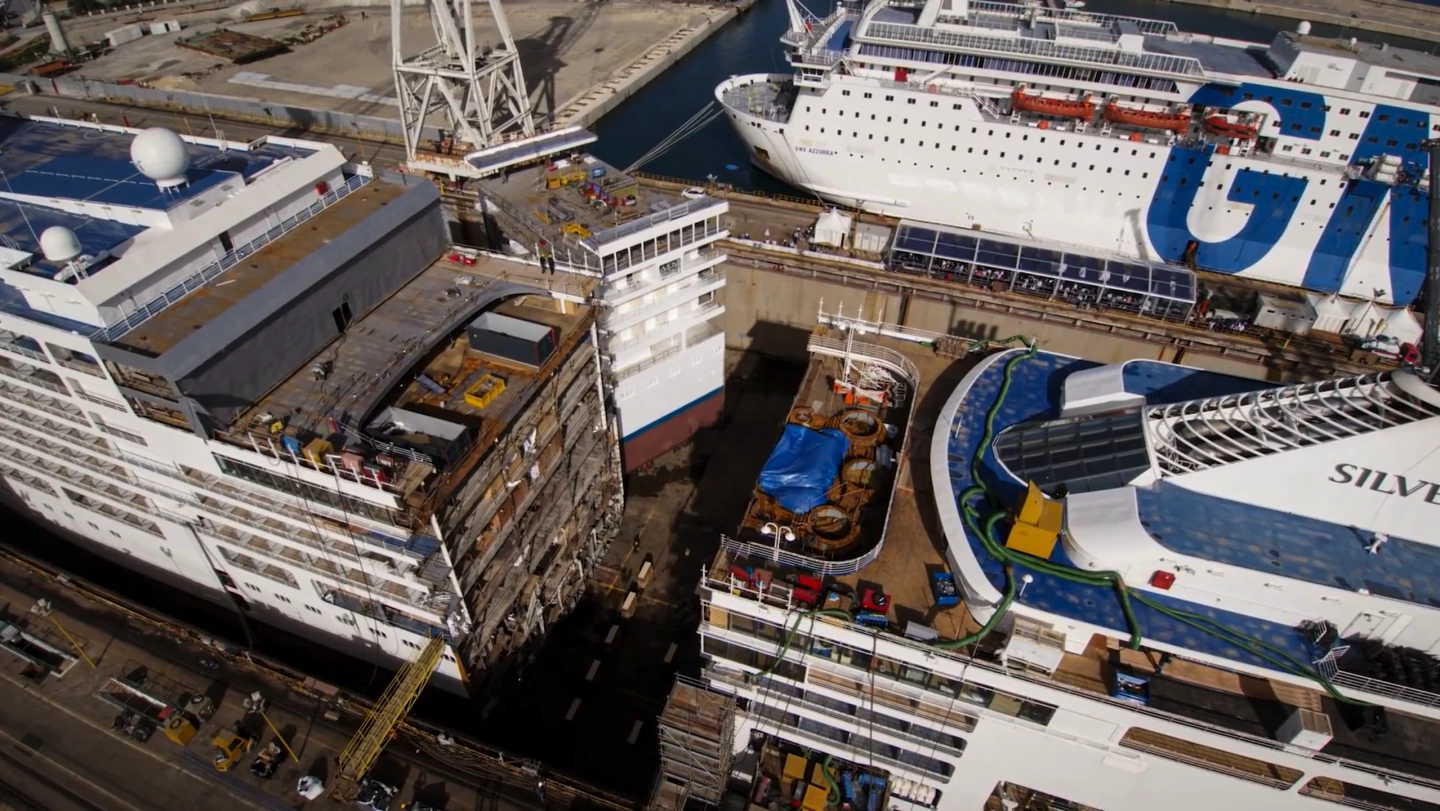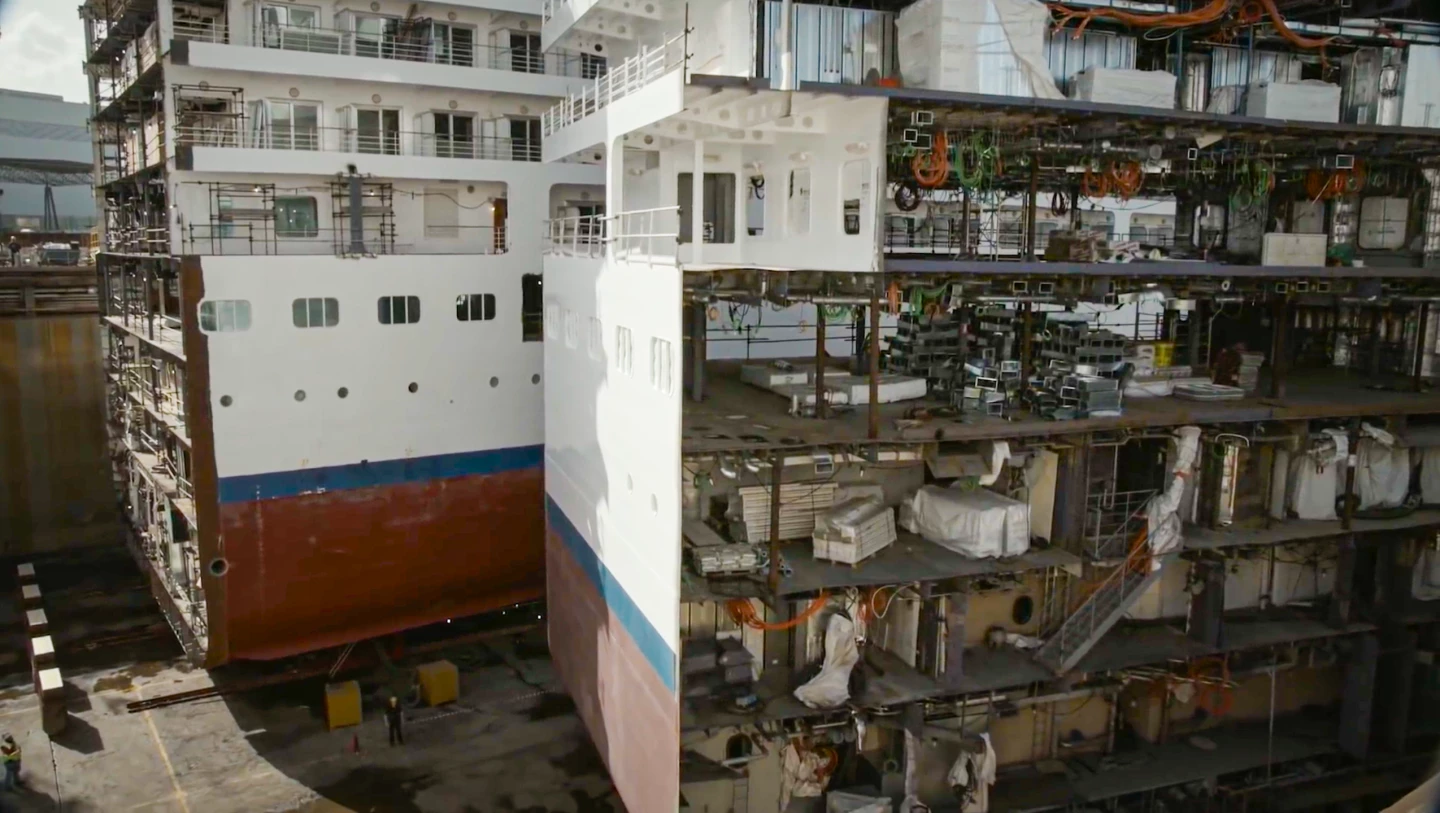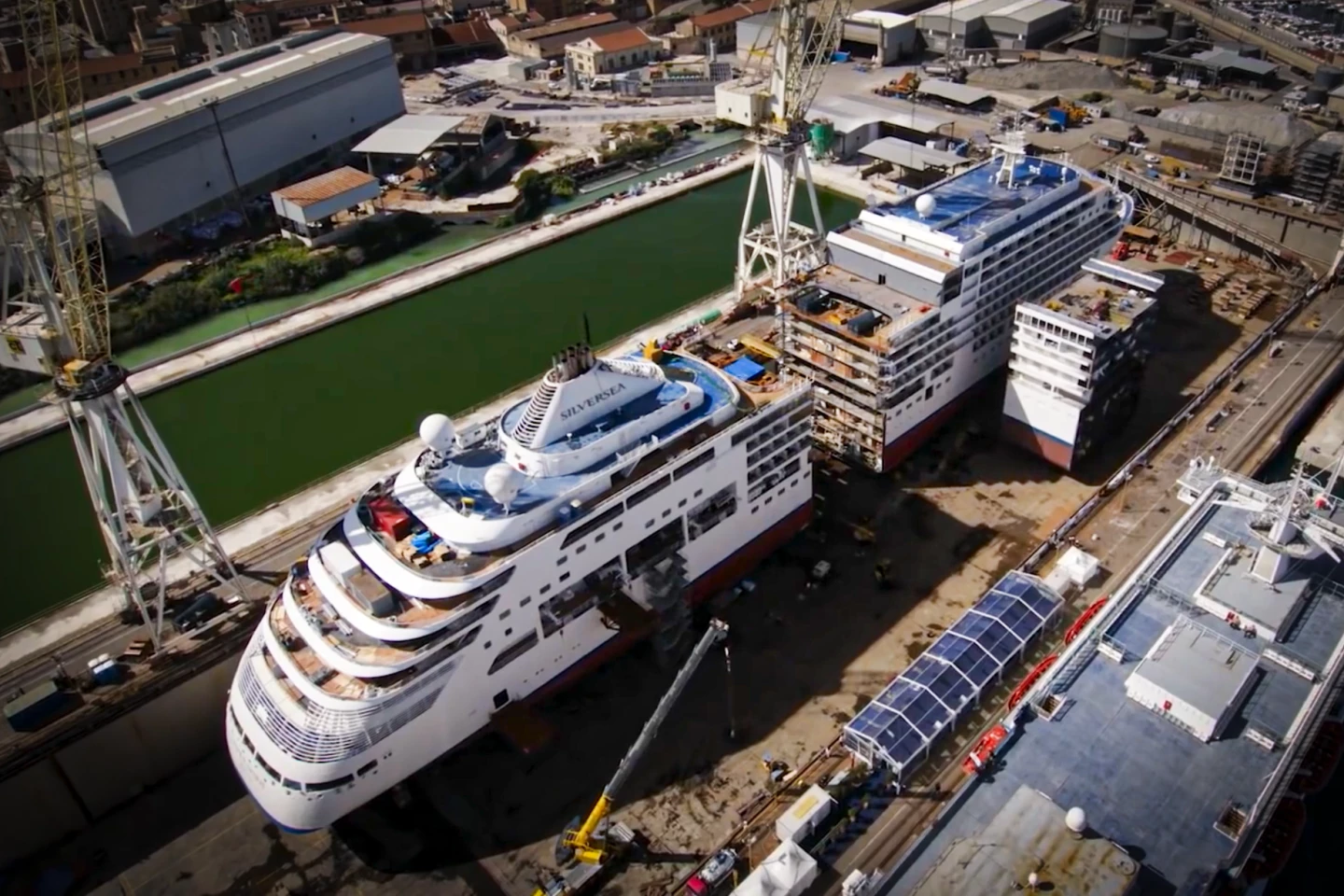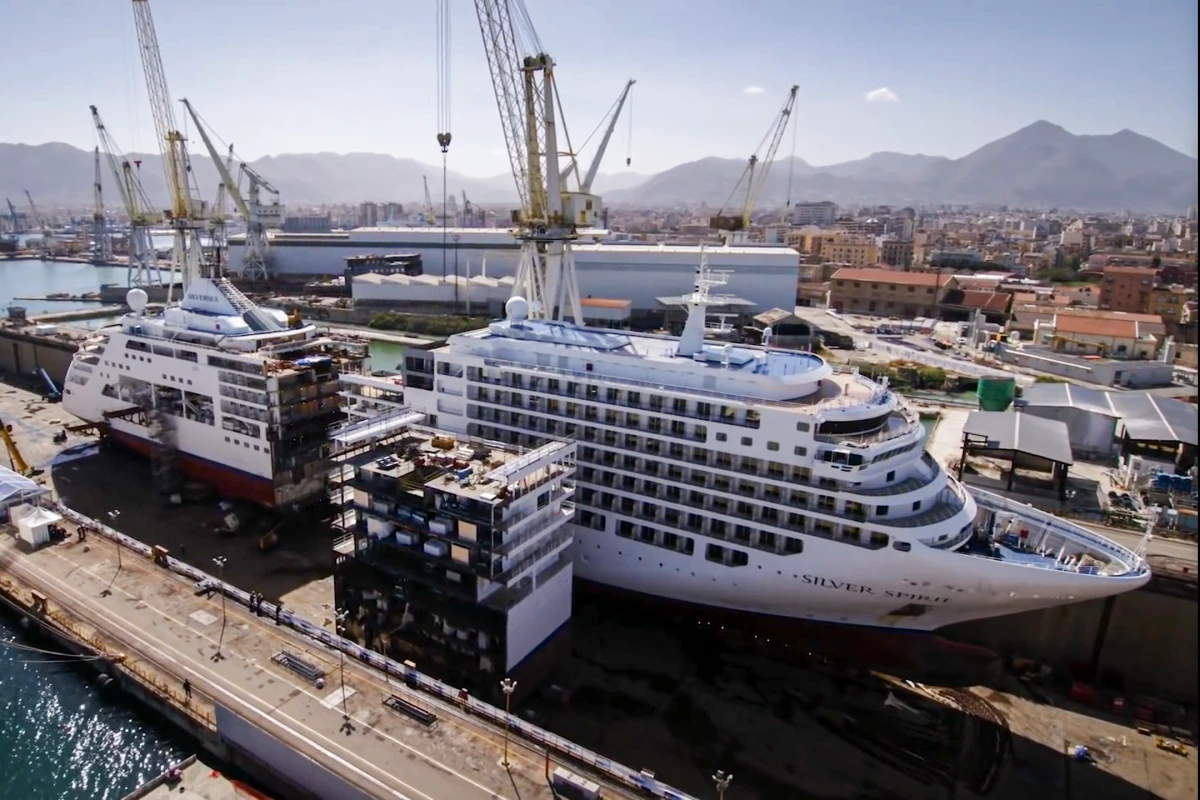Slicing huge cruise ships in half, then welding in an extra segment to lengthen them, is more or less a license to print money for cruise operators – so this 'jumboization' surgery is becoming very common. Let's take a look at how it's done.
Humanity, it seems, can't get enough of cruise ships. In 1990, according to Cruise Market Watch, the global cruise industry treated some 3.7 million passengers to its familiar regime of buffet food, all-inclusive child supervision, shuffleboard, plentiful liquor and winking entertainers. In 2024, that number's tracking closer to 30 million.
So the ships are getting bigger, as evidenced by Royal Caribbean Group's Icon of the Seas, launched this January. This gaudy, teetering behemoth is designed to carry just under 10,000 people, including crew. It's just under 1,200 ft (365 m) long, 159 ft (48 m) wide, and it's stacked no less than 20 decks high, with a technicolour water fun park, 'Aquadome,' seven swimming pools and the industry's tallest waterfall piled on top. Good lord:
But this towering leisure-fest cost around US$2 billion to build, and took around two and a half years to launch from the first steel cutting. The cruise ship industry can't build new ships fast enough to satisfy the rampant demand – and building new ships also means you have to train new crews.
Jumboisation: Ship-lengthening surgery
The cheaper, easier way for operators to expand their carrying capacity and jack up profits is to make existing ships bigger, as it turns out. For an average of around $80 million, and just a couple of months out of service, operators can chop an existing ship down the middle, slide in a new slice that's designed to fit perfectly, weld it together, and come away with enough extra premium cabins to pay off the whole operation within a few years.
That's not to mention the opportunity for a new paint job, bigger deck pools or engine upgrades while the ship's up on blocks – and HR only needs to train a small percentage of extra staff to add to an existing crew. The result: with a much smaller outlay and a negligible gap in service, operators can make an existing boat much more profitable.
'Jumboization,' as the process is known, certainly isn't a new idea, or unique to cruise ships. Indeed, the term itself appears to have been coined just after World War II, at which point shipbuilders were already doing it at enormous scale to lengthen warships, in some of the most complex engineering work ever attempted in the slide rule era.
Nowadays, it's a well-trodden path, with certain shipyards specializing in the process of adding 80-130 ft (24-40 m) to a given cruise ship. The process takes the best part of a year if you include the measure, design and build of the new slice of ship – but remarkably, just a matter of weeks for the actual major surgery itself.
How it's done
First, you need the new chunk of ship ready to roll. Engineers pore over the initial design plans, and then go on board to make hundreds of measurements; clearly, it's got to be precise.
This done, they design the new section. Every one of the thousands of pipes, wires, cables and ventilation channels that'll be cut are designed into the new section, ready to line up perfectly at both ends when the new joins are made. In this way, existing functionality can be maintained – and if the extra cabins place too much demand on existing systems, they can be upgraded to handle their new loads.
Then, they go ahead and build the new section, often complete with interior fit-outs, at a shipyard facility, leaving the ends open. Sometimes, as in the video below of the MSC Armonia, these open sections are actually christened and launched into the water in their own right, and towed to the dry dock where the surgery is scheduled, like floating apartment blocks.
Then, the ship is brought in, and precisely positioned above an array of "skid shoes" – little ship-lifting sleds positioned on metal tracks pre-bolted to the floor of the dry dock. Each of these little sleds is a hydraulic jack capable of lifting as much as 1,000 tons – and each is also capable of applying hydraulic lateral force to move it along the tracks. There might be upwards of 50 of these skid shoes involved in a given ship-stretching operation.
With the ship positioned over the skid shoes, the dock is emptied, and the ship comes down to rest on its new mobile supports.
Then, a work crew that could extend into the hundreds gets to work chopping the ship in half. Laser guides are used to ensure millimeter-level precision, since it's critical that the edges meet perfectly when the new section comes in. And of course, care is taken to plan which bits get cut in which order, because of the enormous weight involved and the associated structural pressures that might result.

The cutting job itself is split between automated cutting machines, which handle the straight surfaces like the side walls and floors, and skilled laborers for curved or complex shapes, but both the machines and the workers use common acetylene blowtorches to cut through the metal.
When the whole ship's been cut right through (memories of a particularly horrifying Three Body Problem scene anyone?) the skid shoes begin the co-ordinated process of pulling the two halves apart, far enough for the new slice to be moved in on its own team of skid shoes. This is also a fine opportunity to load the existing ship segments up with large fitments and items that would otherwise be impossible to get into the lower decks.
The whole ship can be chopped in half and separated in about two days.

Once that's all done, the edges of the stem, middle and stern sections are lined up to perfection using the lifting and moving capabilities of the skid shoes, and then it's time to start connecting things back together. The surfaces are brought together, and the welding begins.
A combination of electrode and stick welding is used – and here's where the extreme cutting precision really comes into play, because the maximum distance that can be covered between the two surfaces is only a few millimeters. The closer, the better – and of course, there's really no margin for error with the watertight hull and the structural supports that'll hold the massive ship together in rough seas.
With the hull, decks and structure all joined together, it's then time to reconnect all the thousands of cables, ducts, wires and other fitments, while interior teams scurry to make the joins seamless on the inside of the ship, and another squad begins to give the whole ship a paint job that'll cover up the welds and scars on the exterior.
The shipyard's responsibility is structural integrity and seaworthiness – but the operator also has to thoroughly test every single electrical, mechanical and hydraulic system on the ship to make sure everything has been reconnected properly. They also need to run sea trials to prove the strength and handling of the new, longer ship.
The whole operation, from when the ship arrives at the dry dock to the point where it's approved to be sent back out into service, can take just nine weeks. If you include the time spent building the new section, as well as all the pre-planning and engineering, the whole project might run out to about nine months.

As I said, this isn't a new process; Wikipedia lists 21 cruise ships that have been lengthened in this way since 1977, and indeed the mighty Seawise Giant – the longest self-propelled ship in history at a staggering 1,504 ft (458 m) end to end – owes some of its prodigious length to the jumboization technique.
But the scale of these operations, the techniques involved and the financial incentives behind them have made it a fascinating rabbit hole for me. I hope you've enjoyed it too!
And if you wanna dive even deeper, take a look at this fantastic mini-doco from Spark:
Source: Spark








